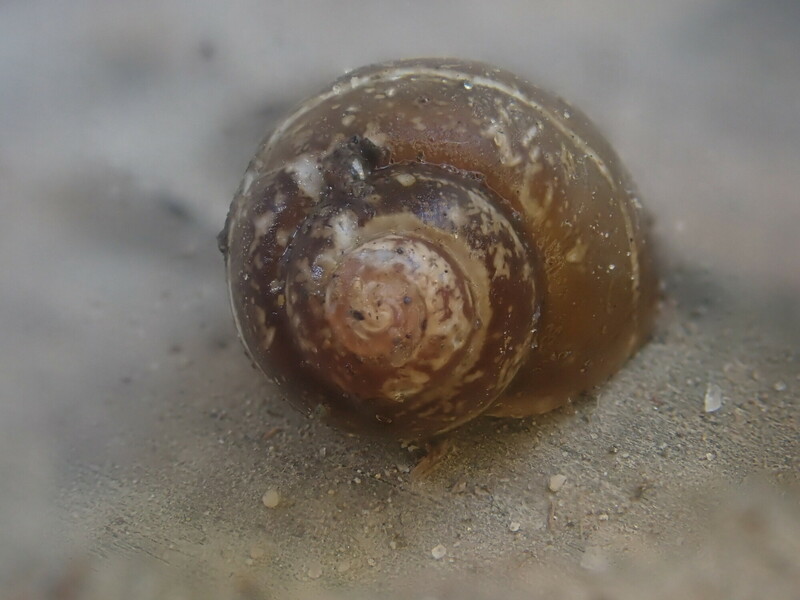The Center for Biological Diversity this week filed a petition with the U.S. Fish and Wildlife Service seeking Endangered Species Act protections for the ashy pebblesnail and shortface lanx.
The two species of freshwater snail were once widespread throughout the Columbia Basin in Montana, Idaho, Oregon and Washington. But the snails have disappeared from Montana and are now living in scattered and isolated populations in the remaining three states.
“These little snails speak volumes about how poorly we’ve treated our Pacific Northwest rivers, which desperately need stronger protections,” said Noah Greenwald, endangered species director at the Center for Biological Diversity. “They also play important roles in the web of life, helping to keep streams clean and providing food for our beloved salmon.”
Ashy pebblesnails are small, tan or reddish snails with pale circles around their tentacled eyes. The shortface lanx is sometimes referred to as the giant Columbia River limpet for its characteristic cone, volcano shape and its propensity to attach itself to rocks on river-bottoms.
Found in large streams with clean, cold and fast-moving water, the ashy pebblesnail and shortface lanx have disappeared from many rivers, including the Willamette, Wenatchee, Clark Fork, Spokane, Kootenay and many more. The snails are threatened by dams, agriculture, urbanization, logging and other threats.
On top of all these harms, climate change is leading to increased stream temperatures across the region, says the Center. “The shortface lanx has already disappeared from the Hanford Reach of the Columbia where it was once common and has been replaced by snail species more typical of warm waters. This warming could spell the end of not just the snails, but many populations of salmon and steelhead that also need clean, cold water,” said the petition.
“If these snails are to survive in our rapidly warming world, we need to do much, much more to protect rivers,” said Greenwald. “Last year’s Sackett decision by the Supreme Court removed protections for roughly half the wetlands across the country. Undoing this disastrous decision is a badly needed start, but we ultimately need even more protections if we’re going to keep our rivers clean and cold in the Pacific Northwest and beyond.”
The Endangered Species Act requires the Service to respond to the petition within one year, though the agency rarely meets this deadline. Protecting these two snails will help protect some of the healthiest remaining rivers in the region, including the Salmon, Methow, Owyhee, Grande Rhonde and Hanford Reach of the Columbia, among others.
The petition says:
“Once occurring throughout the Columbia Basin, including portions of Washington, Oregon, Idaho, Montana and British Columbia, the shortface lanx and ashy pebblesnail have been lost from large portions of their range due to the construction of dams and reservoirs, as well as pollution and habitat destruction related to agriculture, urbanization, logging, livestock grazing and other factors.
“These species no longer occur in many of the rivers they were once found, including the Clark Fork, Spokane, Kootenai, Willamette, Malheur and many more. Sometimes referred to as the giant Columbia River limpet for its characteristic cone, volcano shape, the shortface lanx is limited to cold, swiftly flowing rivers with cobbleboulder bottoms.
“According to the most recent surveys, the shortface lanx may still survive in the lower Snake and Salmon Rivers in Idaho, the Columbia River near Trail, British Columbia, the Methow and Okanagan Rivers in Washington, and the Deschutes, John Day, Imnaha and Grande Ronde Rivers in Oregon.
“Ashy pebblesnails are small, tan or reddish snails with pale circles around their tentacled eyes. According to surveys, the pebblesnail has only two remaining sizable populations in the Methow and Okanagan Rivers, Washington, with smaller populations in the Hanford Reach, Washington; the lower Salmon, North Fork Payette, Boise, Bruneau and Snake Rivers, Idaho; and the Owyhee, Imnaha and Grande Ronde Rivers and Sharon Creek, Oregon.
“Populations of both species are small, isolated and face many of the same threats that resulted in the loss of the species from so many other rivers. They also face the additional and growing threat of climate change, which is resulting in warming stream temperatures and increased incidence of wildfires. The shortface lanx, for example, has been lost from the Hanford Reach of the Columbia, where it was abundant in the early 1990s, likely due to warm river temperatures. As such, the shortface lanx and ashy pebblesnail are clearly at risk of extinction in all or a significant portion of their range, now or in the foreseeable future, and warrant protection as endangered or threatened species under the Endangered Species Act (“ESA”).
“These unique snails are at risk from at least three of the factors under the ESA that qualify a species for protection: the present or threatened destruction, modification, or curtailment of habitat or range; the inadequacy of existing regulatory mechanisms; and other natural or manmade factors affecting their continued existence.”

